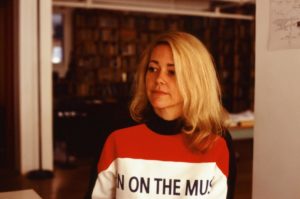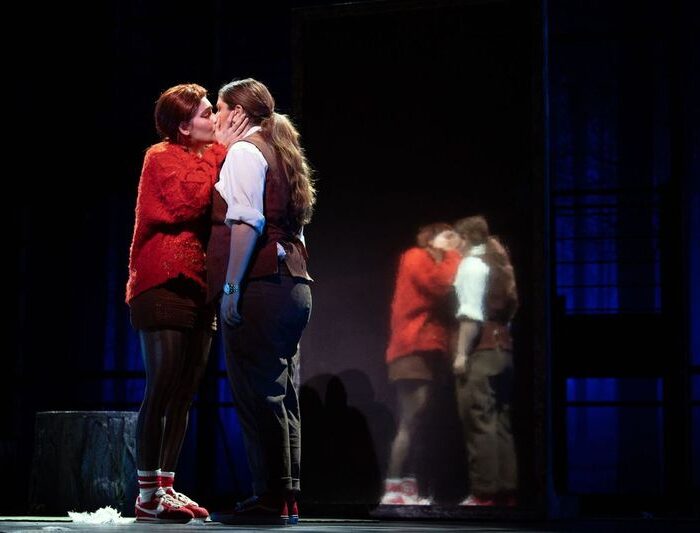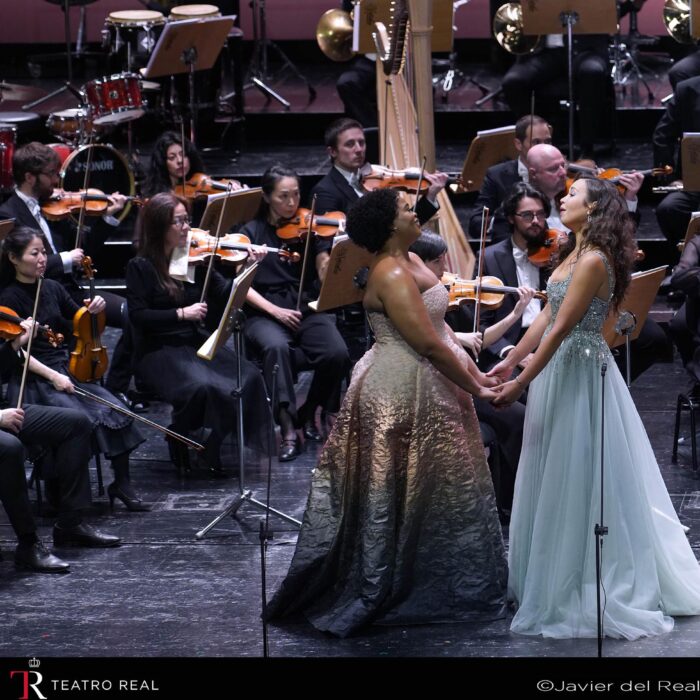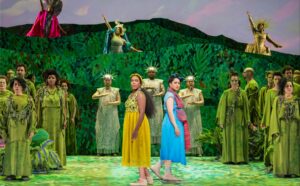
Metropolitan Opera 2023-24 Review: El Niño
Julia Bullock, J’Nai Bridges, Davóne Tines & Marin Alsop Bring Lileana Blain-Cruz’s Creative Vision to Luscious Life
By Jennifer Pyron(Photo: Evan Zimmerman / Met Opera)
Metropolitan Opera debuted John Adams’s “El Niño,” with libretto based on original sources by Peter Sellars and John Adams, to a sold out house of past, present, and future opera goers on Tuesday, April 23rd, 2024. “El Niño” is unlike anything John Adams has done before and the historical timing of this debut is uncanny. This is his fourth work to be performed at Met Opera, including “Doctor Atomic” (2008), “Nixon in China” (2011), and “The Death of Klinghoffer” (2014). Met Opera will debut Adams’s newest opera in 2024-25, “Antony and Cleopatra” (2022), also starring Julia Bullock in the titular role of Cleopatra.
“El Niño’s” pulsing themes of birth, life, death and the radical beauty in between, ushers opera as an art form forward to become the dawn of opera’s new era. History was also made on this night because the majority of the cast made their own debuts, including director Lileana Blain-Cruz, conductor Marin Alsop, soprano Julia Bullock, baritone Davóne Tines, countertenors Key’mon W. Murrah and Siman Chung, set designer Adam Rigg, lighting designer Yi Zhao, projection designer Hannah Wasileski, puppet designer James Ortiz and choreographer Marjani Forté-Saunders.
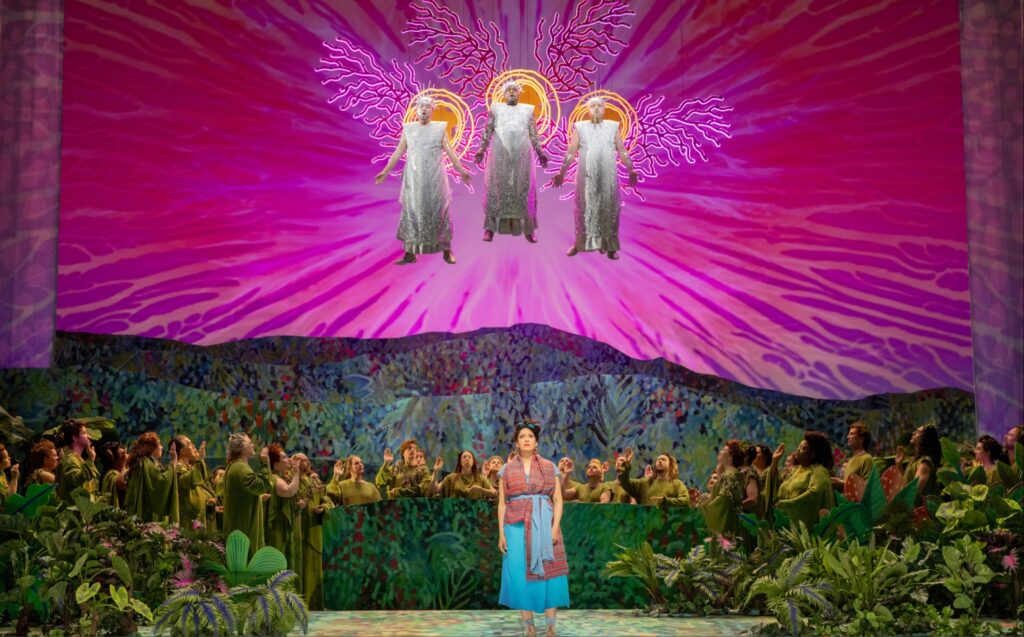
(Photo: Evan Zimmerman / Met Opera)
Music and Libretto Highlights
The libretto is adapted by Peter Sellars and John Adams from poems by Rosario Castellanos, Gabriela Mistral, Hildegard von Bingen, Sor Juana Inés de la Cruz, Rubén Darío, Vicente Huidobro, Martin Luther, and texts from the King James Bible, The Wakefield Mystery Plays and gnostic gospels. This vast spectrum of interpretation creates the body of “El Niño,” resonating a rare fecundity that outweighs efforts of the mind and instead speaks directly to the heart.
“We are shaken through the music and questioning how we want to be in this world. Looking at the news and the chaos we are experiencing, I think the question at the center of ‘El Niño’ is about who we are as human beings and how we want to move forward. We are capable of such beauty and creativity – we are capable of life. But, we are also capable of utterly horrific acts of destruction, like the slaying of children. If you are watching the news right now, we are living in that moment of creative acts of generosity and also people being capable of doing the most devastating things to the most innocent. When I think about why I want to come to the theater and why I want to come to opera, it’s because I want to reckon with that. Both John Adams and Peter Sellars ask us to feel this in our bones. This is why it’s time for ‘El Niño’ right now,” said Lileana Blain-Cruz.
The opera begins with “I Sing of a Maiden.” Its multi-layered musical perspective includes two guitars, samplers, keyboards and orchestra. This nuanced atmosphere stirs and awakens into the story of the Nativity with Mary and Joseph. Conductor Marin Alsop masterfully maintained a permeating sense of wonder, making it easy for anyone to pick up on what was happening and why the libretto includes multiple perspectives.
The music tells the story of the Nativity and motherhood, however it is unlimited in its reasoning with humanity and the complexities of storytelling. “El Niño’s” level of inclusivity binds one’s emotions and infinite range of articulation into a musical web of transcendence that tells the story of all that is and what is to come.
“‘El Niño’ is a multi-dimensional experience. There’s a lot of listening that’s required. It’s a very intense piece. Musically there’s a lot of subtle beauty that’s built out of atmosphere, different moods and colors. The orchestra is incredible. There are two guitars in the center of everything, two samplers, and keyboards. It’s a very ethnic orchestration, more folk music in this way. There’s also a huge orchestra backing it up, so it goes back and forth,” said conductor Marin Alsop.
The Met Opera Chorus sounded rich and grounded in their polyphonic layers. “I Sing of a Maiden” illuminates Adams’s thoughtful design of layering voices as a tapestry in response to the orchestra’s textures and colors. Already there was a profound artistic aesthetic that without the immaculate set design and lighting, which will be highlighted later in this review, one could not tear their eyes and ears away from the music’s development.
Conductor Marin Alsop generated a supportive energy of delight while she conducted. There was a palpable lightness in her direction and grace in her mobility, navigating through the growing climax that loomed and blossomed at the end of this opening. An uneasiness took hold and from this point everything came to life.
“Hail Mary, Gracious!” features the voice of Gabriel as the three countertenors Key’mon W Murrah, Siman Chung, and Eric Jurenas. Together their voices intertwined and naturally gave way to the miraculous announcement being shared with Mary, the news of her immaculate conception. “Hail Mary, Gracious!” might be one of the most critical moments in this opera due to the realization of Adams’s composition for three countertenors as a miracle in itself. Listening to these gentle timbres of immeasurable empathy was undeniably inspirational. Murrah, Chung, and Jurenas became a unified presence for all voices to be heard. There were chills of excitement undulating in response to witnessing this live performance, knowing that moments like this are hard to even describe in words. Life changing!
Soprano Julia Bullock’s voice blossomed as she described the story of her discovery in “Hail Mary, Gracious!” Her soprano radiated clarity and lush fertility. There was also a brightness of conscious reflection all throughout her performance. It was as though Bullock’s life force became greater than the whole of the production, drawing upon the score being kept by the body. She was a resonating channel for all.
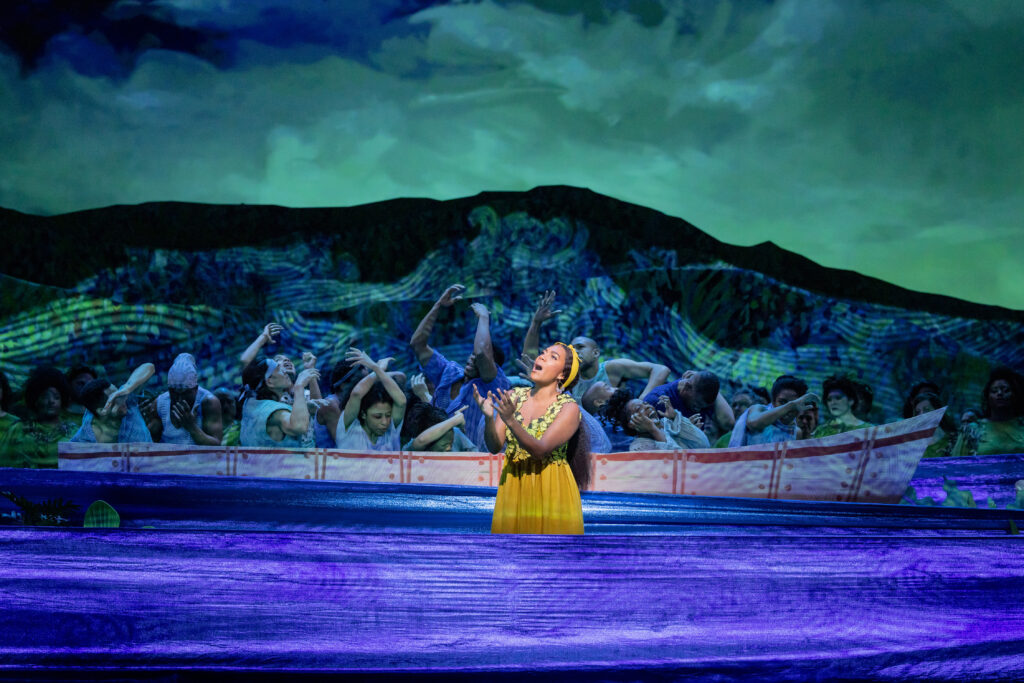
(Photo: Evan Zimmerman / Met Opera)
Interpreting the Body
“‘El Niño’ is a very different work for John Adams. All of his works are thought-provoking. You are changed when you leave the theater after experiencing one of his works. This is what great art is to me. ‘El Niño’ is a piece that has so many different levels, as we all come to it with our own pre-judgement. We all have an idea of what the Christmas story is about – a complex baggage that we bring because each of us, based on what religion you were brought up with and traditions, you have all these things that are coming to the show already. This is a look at the story of the birth of Jesus in a way that’s really unexpected. It’s not simple. The text that is chosen, the Spanish text, is not what you’d think to put in. They have tentacles that go in all different directions. They force you to think about all kinds of different things,” said conductor Marin Alsop.
Mezzo-soprano J’Nai Bridges as the second Mary makes “El Niño” a plural story about all Marys throughout time. Bridges’s voice revealed the intricateness of Adams’s and Sellars’s ultimate dream, illuminating the role of Mary as universal and accessible in “La Annunciacion.” This is a poem by the Mexican poet Rosario Castellanos. She was a novelist and Mexico’s ambassador to Israel, where she tragically died in a household electrical accident. Castellanos words are haunting and ethereal as “La Annunciacion” recognizes the elusive acts of violence made possible in the darkness by men, and the unobtainable justice of all that is. Castellanos is a female voice in mothering response to the moments that make up life and its most challenging traumas, and J’Nai Bridges is an ideal interpreter. Words cannot articulate how otherworldly experiencing Bridges sing “La Annunciacion” really was. I was also reminded of Bridges’s debut performance at the Met as Nefertiti in Philip Glass’s “Akhnaten.” She is a powerful woman of profound wisdom, gratitude and awareness for how art makes changes in the heart’s of men, lighting fires in the guts of many. J’Nai Bridges is an absolute revelation in her craft and construct.
Director Lileana Blain-Cruz’s dedication to building her production around interpreting the body is what makes “El Niño” timeless and so very urgent as an art form to evolve what opera has been, is, and will be to come. Her intelligently founded team of creatives took this production to the new heights that Met Opera dreams about. Set designer Adam Rigg, costume designer Montana Levi Blanco, lighting designer Yi Zhao, projection designer Hannah Wasileski, sound designer Mark Grey, puppet designer James Ortiz, and choreographer Marjani Forté-Saunders drew inspirations from Afro-Caribbean paintings with a two-dimensional pop of color, vibrancy and density. There was also a Baroque two-dimensional staging mixed with Afro-Caribbean painting influences that made “El Niño” feel romantic and very intimate for such a large stage as the Met. Part one features a lush landscape of tropical beauty, imagining what the Divine might look like was the driving inspiration for this setting.
The moment when the scene transitioned into “Shake the Heavens,” starring baritone Davóne Tines as Joseph, was extraordinary! Tines’ voice radicalized the foreboding revelations of violence and destruction when in the face of god’s wrath. Despite the direct lines of symbolism meant to portray spirituality as obviously “transcendent,” this production did the opposite of reducing “god’s call” by turning it inside out and maximizing the hell out of it!
“Shake the Heavens” shocked the Met into a higher vibrational field. Everyone in the audience gasped in thrilling witness. Davóne Tines’ baritone exploded in its range of coverage and conviction. And, as Lileana Blain-Cruz says best, “opera is evolving!!!”
Herod and the Slaughter of the Innocents
In Part two of “El Niño” the libretto pulls from the 1968 Tlatelolco Massacre that took place in Mexico, when a student demonstration ended in a storm of bullets in La Plaza de las Tres Culturas at Tlatelolco, Mexico City. Rosario Castellano’s poem “Memorial de Tlatelolco” is where Part two climaxes, however the lead up to this point must be described first.
“Pues mi Dios ha nacido a penar” (Because my Lord was born to suffer), a text by the 17th-century Mexican poet Sor Juana is the opening of Part two that foretells the suffering ahead. Already there is a deepening fault line of immeasurable power plays at work and the creation of “El Niño’s” Herod, performed by baritone Davóne Tines, must be unleashed.
Tines as Herod took this entire production beyond what was expected in every way possible. What I mean by this is he stepped out of his role as an opera performer and took on the body of Herod as a compulsive force of darkness and destruction. His face was painted in a ghastly silvery grey and his costume was overloaded with heavy gold medals depicting his ruling iron hand. To say that Herod represents any one person in history would be an absolute waste of describing just how complex and universal Adams’s and Sellars’s libretto actually is in the context of historical references. Here is a man of impending doom, leading his followers to their ultimate death. And Tines was very effective in this role. It was excruciating to watch his energy amass into something so inherently wicked and perverse. One might never forget him hastily downing his glass of champagne as he snorted back a thick line of cocaine. He was ready for his kills, lining up his next big cause.
Herod took the floor out from under the gentleness of Tines as Joseph and some might say this was the turning point of his career. Davóne Tines is an absolute force to be reckoned with! His star is blazing on the rise.
The final Castellanos poem, “Una palmera” (A Palm Tree), set for children’s chorus, conducted by Young People’s Chorus Senior Associate Conductor Emma Sway, and guitars weaves emotional discord into harmony through the naïveté and hope of young voices. The Young People’s Chorus of NYC, founded by Francisco J. Núñez, was the perfect ensemble to sing this concluding moment. Núñez is a major component in developing young voices and inspiring communities through collaborative works and performances here in NYC. This dedication to every young voice made this last song very emotional for me. As I watched the curtain screen gently lower, and the fog machine billow forth its final blow, there was nothing I wanted to separate me from the purity and gentleness of the children’s voices. The “poetry” of this life and the poet as a child.
John Adams’s “El Niño” is changing the course of what opera can and will do for our world, one voice at a time.
